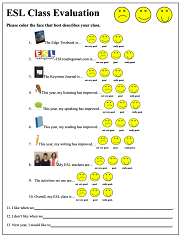Holly Niemi offers ideas on how ELLs contribute to feedback and reflection at the end of the school year.
The end of the school year upon us. It is important to take a moment to reflect on the variety of assignments, activities, and assessments completed over the course of the 2013-2014 school year. Now is a great time to consider ESL class successes and areas of improvement, while they are fresh in mind. Feedback and reflection from the ESL teacher’s point of view is critical, but it is essential to consider those impacted the most by instruction, the ELLs. The feedback and reflection ELLs can provide about an ESL teacher’s instruction can be invaluable. Their insight can help an ESL teacher improve and refine future teaching and learning. Our high school requires each teacher distribute and collect a class evaluation survey for each student, including all levels of ELLs. In order to do this with ELLs, my class evaluation was extremely visual by design, in order to maximize valid and reliable responses from ELLs of varying levels of English proficiency, ranging from level 1 to level 5 ELLs. A sample of my ESL class evaluation is below.
The above ESL class evaluation took ELLs approximately 10 minutes to finish during class and was completely anonymous. The advantage of an in-class survey is the high response rate and 100% student feedback. Although, the downside may be that ELLs will not be as honest, but this can be reduced by having a guest teacher administer the survey, so the teacher of record is not present. It allowed students to provide feedback to quantitative questions consisting of a visual Likert scale response, ranging from a sad to happy face, as well as a mix of free-response qualitative questions at the end of the survey. Questions 1-10 allow the teacher to calculate quantitative results and questions 11-13 provide the teacher with qualitative student data. Combined, this survey affords the teacher feedback and reflection to set teaching goals and expectations for the coming school year. Be prepared for both positive and negative feedback. In any case, look for patterns and trends when identifying course strengths and weaknesses.
Overall, the ELLs’ opinion of the class can help inform future teaching and learning to benefit both the ESL teacher and ESL students.


No comments:
Post a Comment